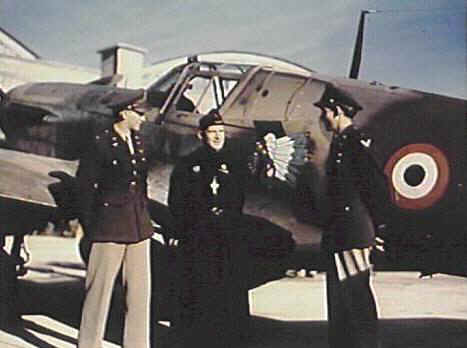by Martin Waligorski
How Good is Good Enough?
The P-40 was the last and best known of Curtiss Hawk series fighters initiated in the 1920s. It’s qualities were, and are, controversial.Criticised by many for poor manoeuvrability, low speed and rate of climb, it was on a verge of being obsolescent already before series production started. The inadequacies of the P-40 were widely publicised in the initial war years and even became the subject of a Congressional investigation.
Still, the P-40 was used successfully by many Air Forces during the war. One of the first customers was RAF, where the fighter named Kittyhawk distinguished itself in the African and Italian campaigns. It also did pretty well in USAAF service during the first year of Japanese advance in the Pacific, when little else (namely the P-39 Airacobra) was available in quantity. Popularised as the aircraft used by the Flying Tigers (American Volunteer Group) in China, it also helped to produce one of the first morale-boosting ’success stories’ of the American Air Force in the war against Japan. It is with this unit that the P-40 achieved immortal fame.
Another large user of the P-40 was the Soviet VVS. Interestingly, although favoured by USSR pilots, Josef Stalin himself opted for Bell P-39 over P-40 as ”more suited for combat against German fighters.” On what grounds his opinion was based remains a mystery.
The P-40 had no serious vices and was a pleasant aircraft to fly. When flown by an experienced pilot was able to give a good account of itself in aerial combat. It’s indisputable advantage was also very tough construction, which made the aircraft capable of bringing it’s pilot home despite sometimes heavy damage.
Contrary to it’s opinion of a stop-gap measure, the production of P-40 continued long after more modern types were readily available. The total number of P-40 manufactured reached the third highest total for American World War II fighters, bettered only by the Republic P-47 Thunderbolt and the North American P-51 Mustang. These production numbers can be deemed the ultimate measure of the aircraft’s usefulness.
And besides, do you know any other aircraft that looked better with the sharkmouth?

Do you know any other aircraft that looked better with the sharkmouth? Often associated with American Volunteer Group (AVG) in China, this motive was actually ”discovered” by No. 112 RAF Squadron in North Africa, then adopted by AVG and many other air force units flying P-40s all over the world, including countries like Brazil!
Illustration (c) 1999 Thomas A. Tullis. Used with permission.
A Quick Guide to P-40 Variants
Unsurprisingly for the massive production of almost 14,000 aircraft, the P-40 went through many changes during it’s life. Little resemblance can be found between last production variants and the original concept. This guide is intended to help identifying the production versions and spot the major differences between them.
- XP-40 Prototype – The P-40s immediate ancestor was Curtiss P-36 (Model 75), a radial engine-powered fighter later flown by the French Air Force against Luftwaffe in 1940. The P-36 design was reworked to incorporate the liquid-cooled Allison V-1710 engine equipped with a supercharger, resulting in the XP-37. Thirteen YP-37 service-test aircraft were built, but major problems with the supercharger installation caused the development of the P-37 to be abandoned in favour of a less complex installation of the Allison V-1710 engine. Tenth production P-36A was converted to the new prototype. This project was given the designation Curtiss Model 75P, and the USAAC gave the project a new fighter designation, XP-40. The prototype first flew on October 14, 1938. It went through several modifications, several different positions and configurations of oil cooler had been tried affecting the aircraft’s silhouette.
To make a very long story short, here’s the list of major production variants:
- P-40 – the original production version to USAAC specification. The armament was limited to two 0.50″ machine guns located in the fuselage. The engine was V-1710-33. The first machine left the factory in May 1940. The model differed from the XP-40 prototype by having flush-riveted surface instead of drag-inducing conical rivets used in P-36. Following the new USAAC designation, Curtiss gave it’s new fighter the internal designation H-81 (Curtiss Hawk Model 81)
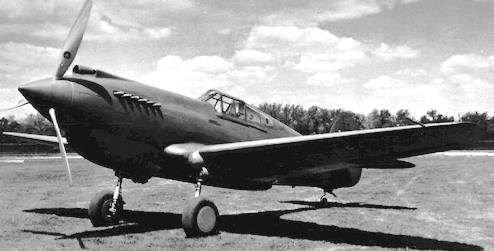
A first production version P-40 can be recognised by armament concentrated solely above the engine.
Wing-mounted guns would be introduced in all subsequent versions.
- H-81A – export version for the Armée de l’Air, of which 140 were ordered. The first production machine flew in June 1940, too late to enter the French service. The contract was overtaken by RAF after the fall of France.
- Tomahawk Mk. I – In the British service the ”French” aircraft were named Tomahawk Mk. I. The machines were identical to the P-40, except for the instruments and equipment. Even the armament was improved with four wing-mounded machine guns. The first Tomahawks reached England in September 1940.
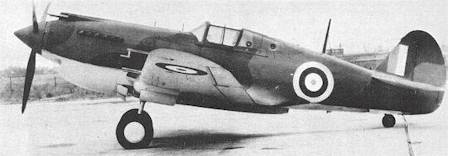
This is Tomahawk Mk. I, modified to the RAF specification with four wing-mounted 0.303″ Brownings. Installation of British radio equipment resulted in a radio mast halfway down the rear fuselage.
- P-40B – differed from the P-40 by improved armament obtained by two extra 0.30″ machine guns in the wings. Heavier weight coupled with the same engine resulted in performance inferior to that of the P-40. Ca. 130 were produced, deliveries starting from March 1941.
- Tomahawk Mk. IIA – was the export version of the P-40B for the RAF. The wing guns were replaced by two 0.303″ calibre Brownings, and British radio was installed. It also had armour protection for the pilot and first version of self-sealing fuel tanks. 110 were produced, 23 of which were sent to the Soviet Union.
- P-40C – Delivered from April 1941, 193 were manufactured. Improved fuel system allowed for a drop fuel tank below the fuselage. Self-sealing tanks were introduced with this model, and the armament was yet increased to four 0.30″ wing-mounted machine guns and two 0.50″s in the fuselage. More gain in weight caused the performance to be even worse than that of P-40B.
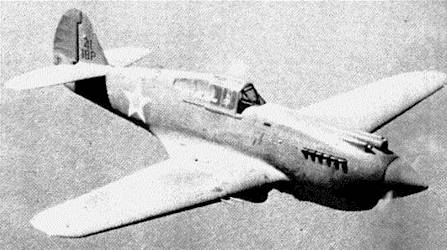
P-40C displays it’s four-gun installation in the wing,which was a distinctive feature of this version.
- Tomahawk Mk. IIB – export equivalent of the P-40C. 930 were built. 100 of these planes were transferred to China for the ”Flying Tigers”, and 195 were sent to Russia. Mk. IIB was also extensively used by RAF and SAAF in Africa – as much as sixteen squadrons were equipped with the type. Armament was again increased to four (some sources state six) wing-mounted 0.303″ guns in addition to two 0.50″ guns in the fuselage. The US radio equipment was retained on this model.
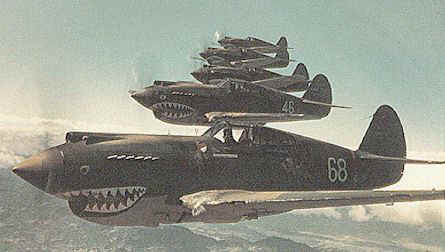
This excellent period photograph shows a flight of ”Flying Tigers” Tomahawk Mk. IIBs in flight over China. Various sources refer to AVG machines as being P-40Bs or P-40Cs, but they were actually produced for British contract to Tomahawk Mk. IIB standard.
The first machine is flown by Charles Older, AVG. It appears to have only two wing machine guns mounted.
- P-40D – delivered from May 1941. The engine was finally upgraded to V-1710-39, which produced more power and had better high altitude performance. The engine was now 18 inches shorter, and the prop thrust line 8 inches higher. The airframe adaptation was therefore extensive, and prompted a new internal Curtiss designation of Model 87. The aircraft received an entirely new fuselage with shorter nose, enlarged chin intake and sleeker cross-section that we today associate with the P-40. The fuselage guns were deleted, four 0.50″ guns being installed in the wings. Armour protection was improved, and wing hardpoints introduced to carry bombs.
Only 22 Ds were produced before the order was changed to accommodate six guns. Curtiss promptly responded to this request, but the modified aircraft received the designation P-40E. - P-40E – as stated above, it was identical to the D-version except for six wing-mounted machine guns.
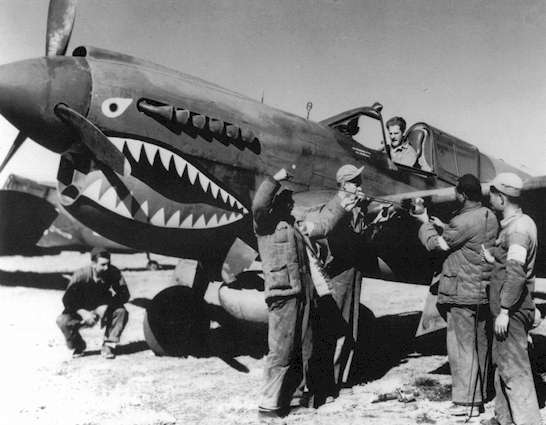
The completely redesigned nose accommodating the Allison V-1710-39 can be seen in detail on this photo, which the author believes to show one of the AVG P-40Es. ”Flying Tigers” received their first Es in March 1942, after the lack of spare parts and combat attrition reduced the unit’s strength to only 20 flyable P-40Cs.
- Kittyhawk Mk. I – even the British recognised the new-generation P-40 as an entirely new aircraft, designating it Kittyhawk.
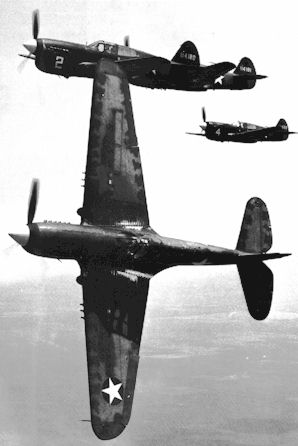
These early series P-40Fs show the airframe generally similar to that of P-40E with shot rear fuselage.
The first 20 were delivered to P-40D specifications, remaining ones being identical to P-40Es with exception of British equipment such as radio installation. The designation Kittyhawk Mk. IA was used for the latter to distinguish between these two variants. An aircraft of this batch, NZ3009, is a photographic subject of the In Detail article in this issue. Totally Britain received ca. 1500 Mk. Is.
The American designation P-40E-1 was adopted to identify the 1500 Kittyhawk Mk. IAs shipped to Britain early in the Lend-Lease program to distinguish their British equipment from those in the US service. Many were actually retained for US service, identifiable by their British-style camouflage.
- P-40F – In USAF service the type received the name Warhawk. The engine was exchanged once more, this time to he vastly superior Roll-Royce Merlin 28 (later Packard Merlin V-1650-1) with a single-stage supercharger built into the P-40D airframe . With the new engine the carburettor air intake on top of the cowling was removed.
The first 699 production aircraft were designated only P-40F, after which the subtype numbers were introduced to keep track of modification introduced directly in production. The ”dash numbers” were assigned according to the system: -1, -5, -10, -15, -20 and so on, with interval of 5. Thus the first P-40Fs were retroactively treated as P-40F-1, and subsequent modifications were designated P-40F-5, P-40F-10, P-40F-15, P-40F-20. Actually the official designations carried an additional suffix -CU indicating Curtiss production facilities, like P-40F-10-CU, but we’ll omit it here for clarity.
The P-40F-5 and later production models had the rear fuselage lengthened with over 2 feet to improve directional stability. Of note is that only fin and rudder were moved back, the horizontal tailplane remained in the same position.
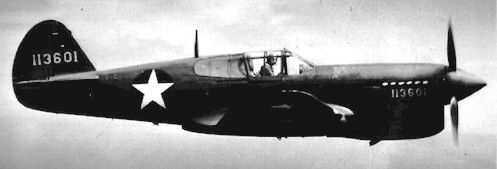
113601 was the second production P-40F. The most prominent feature of the Merlin-powered Warhawkswas lack of carburettor air scoop on top of the cowling.
- Kittyhawk Mk. II – of over 1300 P-40Fs produced, 150 were supplied to Britain under Lend-Lease and designated Kittyhawk Mk. II, in common with the later P-40L model. The RAF didn’t actually use their Mk. IIs – 80 were returned to USAAF for Tunisian campaign, 100 went to Soviet Union, and a handful was handed over to Free French AF in Africa.
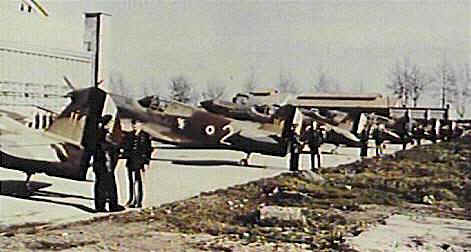
Seven of the RAF Kittyhawks Mk. II were handed over to the Free French Air Force in Africa. Almost all of these aircraft can be seen on the above photo. The aircraft are representative of the late P-40F production with lengthened fuselage.
- P-40G – name given to 44 existing airframes retrofitted in summer 1941 with wings from Tomahawk Mk. IIA and consequently armed with only four small-calibre guns. Sixteen were shipped to Soviet Union, the rest being used in the US for training duties.
- P-40H, P-40I, P-40J – designation never used. The P-40J was a projected P-40E with supercharger, but the idea was dropped at an early stage.
- P-40K – originally planned as final production variant. Although a P-40F proved a superior machine due to the installation of the Merlin engine, the Allison-powered versions were still produced because of the limited supply of the Merlins. The P-40K was powered by the new V-1710-73.
The first production machine rolled off in August 1942. Early production K models were similar in shape to P-40E, but the dorsal fin was added to improve the stability with the new engine. From the P-40K-10 series the problem was solved by adapting the long rear fuselage of the P-40F.
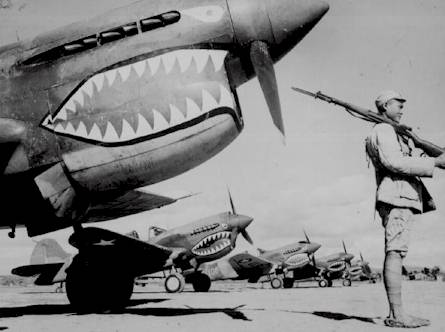
Early production P-40Ks featured a short fuselage of the P-40E with enlarged fin,which can be seen on the second aircraft.
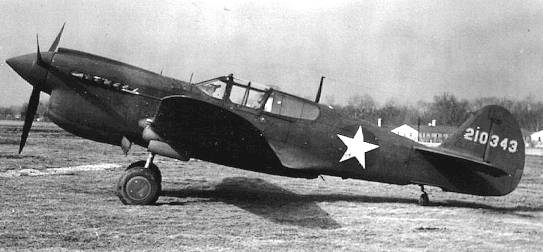
Late series Ks looked much different. The P-40K-15 presented heredisplays a long style fuselage. The K-15 series carried special equipment for winter conditions.
- Kittyhawk Mk. III – the RAF equivalent of P-40K. 192 were received through Lend-Lease. Most of them were re-distributed to Commonwealth air forces.Name Kittyhawk Mk. III was also used for other P-40 variants – see below.
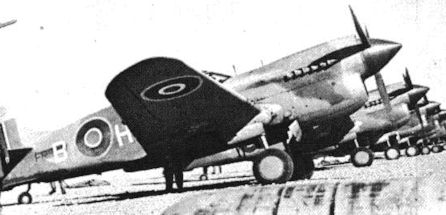
A row of British Kittyhawks Mk. III. The nearest aircraft is a machine from P-40K-1 series,which can be read from the partially obscured RAF serial FR3??.
An interesting detail is a non-standard camouflage pattern on the first aircraft’s nose.
- P-40L – this version was envisaged as a lightweight fighter. Based on P-40F-5, the weight was saved by reducing armament to four 0.50″ calibre guns, removing some armour and reducing fuel capacity. In the initial production batches, however, these changes were not performed, which makes it very hard to distinguish them from P-40F. From the P-40L-5 batch onwards the modifications were carried out. The performance improvement over the P-40F proved to be insignificant. Nevertheless 700 aircraft were built.
- Kittyhawk Mk. II / Mk. III (P-40L) – The British first received 100 P-40Ls which were marked Kittyhawk Mk. II with no distinction from the P-40F. The second batch of 160 aircraft of this version was for unknown reason designated Kittyhawk Mk. III, thus causing possible confusion with P-40Ks of the same Mark.
- P-40M – In 1943 the short supply of Merlin engines again forced Curtiss to re-introduce the Allison powerplant to production lines, resulting in the P-40M. The engine used was V-1710-18. The airframe was similar to P-40K-20, the visible difference being an introduction of a rectangular cooling panel in front of the exhaust stacks. Deliveries started in November 1942. This version was built exclusively for Lend-Lease ”export” and was used by RAF, SAAF, RAAF and RNZAF under the designation Kittyhawk Mk. III. Some machines, however found their way to US service in China and the Mediterranean.
- Kittyhawk Mk. III (P-40M) – Still more source of confusion is that the British term Mk III was also used for P-40Ms, indicating that RAF didn’t recognise the difference between the P-40M, K (which can be understood) and L (which is somewhat weird).
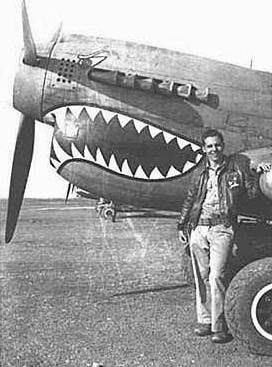
The P-40M introduced the rectangular cooling gill just in front of the exhaust stacks. This is one of the machines serving with 14th Air Force in China.
- P-40N – This last production version was also the most numerous. A total of 5220 machines were built. Powered by V-1710-81 (later -99 or -115), it featured several changes to reduce weight. These included new light alloy coolers and radiators, smaller and lighter main undercarriage wheels, and several structural changes. Armament was reduced to 4 machine guns.There were several differences between production batches,. These are described below.
- P-40N-1 was intended for high altitude combat. The weight-saving changes resulted in the fastest production version of the P-40. Four hundred were built.From P-40N-5 batch a new canopy was introduced with frameless sliding portion and a new transparent rear part to improve pilot’s field of view. The armament was yet again increased to six Brownings. Even external store capacity was increased.
The P-40N-15 introduced minor internal changes as well as new landing lights.
A revised instrument panel in the cockpit was installed starting from P-40N-25.
The P-40N-26 was a conversion of P-40N-5 for reconnaissance duties with cameras installed in the fuselage.
P-40N-35 introduced minor changes to the instrument panel and lighting.
Finally, the P-40N-40 had flame-damping exhaust and some minor internal changes.
There were more internal modifications made during the long production run of the version, but these are not mentioned here in detail. The production ended in November 1944 with P-40N-40.
Main users of the ”N” Warhawk were Lend-Lease customers. Over 1000 machines were sent to Russia. 586 were ordered by the RAF, and designated Kittyhawk Mk. IV. The RAF diverted most of their machines to overseas service and to Soviet Union. Australia received 468 aircraft, 172 went to New Zealand. USAF used the type mostly for training.
A few machines remaining in service after the war were re-designated ZF-40N in 1948.
- Kittyhawk Mk. IV – RAF designation of P-40N. Of 586 ordered 130 were later re-directed to Soviet Union.
- P-40Q – this was manufacturer’s last attempt to put life in an ageing design, and resulted only in a prototype. The P-40Q only partly resembled the previous versions, featuring major changes like the bubble canopy, clipped wings, cooler intake moved below the wing centerplane, a yet longer fuselage with completely re-designed nose and a four-blade propeller. Three XP-40Q prototypes were built and yes, the aircraft was much more capable than any of the previous versions, but still no match for the P-51 Mustang. The project was cancelled.
- P-40P – Planned Merlin-powered variant of the P-40N, which didn’t materialise due to shortage of engine supplies.
- P-40R – a batch of about 70 P-40Fs was converted to the Allison V-1710-81 engine in place of the Merlin. These machines were used in the US as advanced trainers, designated P-40R-1.
- Similarly converted aircraft of the P-40L version were called P-40R-2. The number of such conversions performed is not known, but there were more than 50.
- The same designation P-40R-1 was also given to a trainer conversion of P-40N-30, of which 70 were made.
Serial Numbers
The table below states production numbers for all (I hope) P-40s produced. This section is based on Joe Baugher’s excellent research published at his home page.
| Version | US serial numbers | RAF serial numbers | RAAF serial numbers | RNZAF serial numbers |
| P-40 | 39-156..280 40-292..357 |
|||
| Tomahawk Mk. I | AH741..880 | |||
| P-40B | 41-5205..5304 41-13297..13327 |
|||
| Tomahawk Mk. IIA | AH881..990 | |||
| P-40C | 41-13328..13520 | |||
| Tomahawk Mk. IIB | AH991..999 (all to VVS) AK100..570 (36 to AVG) AM370..519 (64 to AVG) AN218..517 |
|||
| P-40D | 40-359..381 | |||
| P-40E | 40-358 40-382..681 41-5305..5744 41-13521..13599 |
|||
| Kittyhawk Mk. I & Mk. IA | AK571..999 AL100..230 |
|||
| P-40E-1 (Kittyhawk Mk. IA) | 41-24776..25195 41-35874..36353 41-36354..36953 |
ET100..999EV100..699 | A29-1..163 | NZ3001..3044 NZ3091..3098 NZ3100..3108 NZ3271 |
| P-40F | 41-13600..13695 41-13697..14299 |
|||
| P-40F-5 | 41-14300..14422 | |||
| P-40F-10 | 41-14423..14599 | |||
| P-40F-15 | 41-19733..19932 | |||
| P-40F-20 | 41-19733..19932 | |||
| Kittyhawk Mk. II (P-40Fs and Ls) | delivered from series 41-13697..14599 |
FL219..448 | ||
| P-40G | 42-14261..14274 42-14277..14278 42-14281 |
|||
| P-40K-1 and Kittyhawk Mk. III | 42-45722..46321 | FL875..905 FR111..115 FR210..361 FL710..713 |
NZ3045..3065 NZ3090 NZ3099 |
|
| P-40K-5 | 42-9730..9929 | |||
| P-40K-10 | 42-9930..10264 | A-29-164..202 | ||
| P-40K-15 | 42-10265..10429 | A-29-203..205 | ||
| P-40L-1 | 42-10430..10479 | |||
| P-40L-5 | 42-10480..10699 | |||
| P-40L-10 | 42-10700..10847 | |||
| P-40L-15 | 42-10848..10959 | |||
| P-40L-20 | 42-10960..11129 | |||
| Kittyhawk Mk. II (P-40L) | FS400..499 | |||
| Kittyhawk Mk. III (P-40L) | FL714..730 FR116..140 FR385..392 FR413..521 |
|||
| P-40M-1 | 43-5403..5462 | |||
| P-40M-5 | 43-5463..5722 | |||
| P-40M-10 | 43-5723..6002 | |||
| Kittyhawk Mk. III (P-40M) | 43-5403..6002 | FR779..872 FS100..269 |
A29-300..389 A29-400..414 A29-420..434 A29-442..460 A29-473..502 |
NZ3066..3073 NZ3075..3089 NZ3109..3119 NZ3180 |
| P-40N-1 | 42-104429..104828 | A29-415..419 A29-435..442 A29-461..472 A29-503..541 A29-559..563 A29-577..587 |
||
| P-40N-5 | 42-104829..105928 | A29-542..558 A29-564..576 |
||
| P-40N-10 | 42-105929..106028 | |||
| P-40N-15 | 42-106029..106405 | |||
| P-40N-20 | 42-106406..106428 43-22752..24251 |
A29-600..704 | ||
| P-40N-25 | 43-24252..24751 | A29-800..811 A29-819..828 |
||
| P-40N-30 | 44-7001..7500 | A29-900..928 | ||
| P-40N-35 | 44-7501..8000 | A29-1000..1079 | ||
| P-40N-40 | 44-47749..47968 | A29-1100..1221 | ||
| Kittyhawk Mk. IV | FS270..399 (all to VVS) FT849..954 FX498..847 |
NZ3120..3179 NZ3182..3270 NZ3272..3293 |
This article was originally published in IPMS Stockholm Magazine in September 1999.
